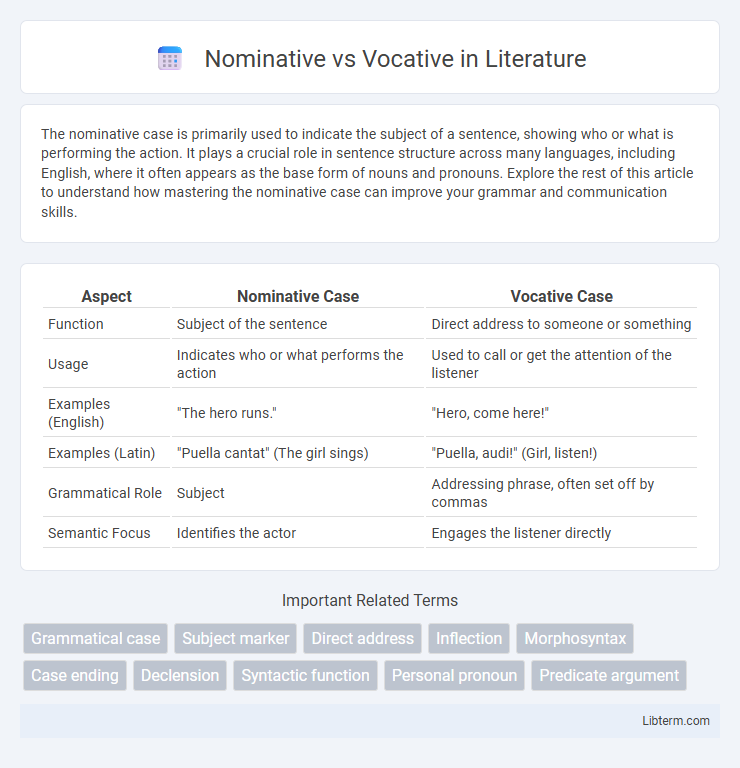The nominative case is primarily used to indicate the subject of a sentence, showing who or what is performing the action. It plays a crucial role in sentence structure across many languages, including English, where it often appears as the base form of nouns and pronouns. Explore the rest of this article to understand how mastering the nominative case can improve your grammar and communication skills.
Table of Comparison
| Aspect | Nominative Case | Vocative Case |
|---|---|---|
| Function | Subject of the sentence | Direct address to someone or something |
| Usage | Indicates who or what performs the action | Used to call or get the attention of the listener |
| Examples (English) | "The hero runs." | "Hero, come here!" |
| Examples (Latin) | "Puella cantat" (The girl sings) | "Puella, audi!" (Girl, listen!) |
| Grammatical Role | Subject | Addressing phrase, often set off by commas |
| Semantic Focus | Identifies the actor | Engages the listener directly |
Introduction to Nominative and Vocative Cases
The nominative case primarily identifies the subject of a sentence, indicating who or what is performing the action. In contrast, the vocative case is used for direct address, calling out to or invoking someone or something within a conversation. Understanding these cases enhances clarity in communication by distinguishing between the subject and the entity being directly spoken to.
Defining the Nominative Case
The nominative case identifies the subject of a sentence, typically a noun or pronoun performing the action of the verb. It is essential in sentence structure to indicate who or what is executing the action, such as "She" in "She runs fast." Unlike the vocative case, which addresses or calls upon someone directly, the nominative strictly functions as the subject in grammatical construction.
Understanding the Vocative Case
The vocative case is used to directly address or call upon a person or entity, distinguishing the addressee from the rest of the sentence components typically marked by the nominative case. Unlike the nominative case, which identifies the subject performing an action, the vocative case often appears as a separate element set off by commas, such as in "Maria, come here." Understanding the vocative case involves recognizing its function in dialogue and commands to clearly indicate who is being spoken to, essential in languages like Latin, Greek, and some Slavic languages.
Key Differences Between Nominative and Vocative
The nominative case identifies the subject of a sentence, often used for the doer of an action, while the vocative case directly addresses or calls upon someone or something. In languages like Latin, Greek, or Sanskrit, nominative forms serve grammatical functions as subjects, whereas vocative forms are employed in direct speech to grab attention or invoke. Unlike the nominative, the vocative typically appears without verbs and frequently includes specific endings or particles marking the address.
Functions of the Nominative Case
The nominative case primarily functions as the subject of a sentence, indicating who or what performs the action of the verb. It also serves as the predicate nominative, linking the subject to a subject complement after linking verbs like "to be." In contrast, the vocative case is used for direct address, calling or speaking directly to someone or something, which does not perform grammatical functions within the sentence structure.
Functions of the Vocative Case
The vocative case functions primarily to directly address or call upon a person or entity, distinguishing the addressee from the rest of the sentence. It often conveys emotion, urgency, or command, making it essential in speech for capturing attention or expressing feelings. Unlike the nominative, which marks the subject of a sentence, the vocative isolates the listener or interlocutor as the focus of communication.
Examples of Nominative Case in Sentences
The nominative case identifies the subject performing the action in a sentence, as seen in examples like "She runs every morning" and "The cat sleeps on the sofa." It answers the question "who" or "what" is doing the verb, for instance, "John reads a book" uses "John" in the nominative case. Unlike the vocative case, which directly addresses someone, the nominative case simply states the subject without direct address.
Examples of Vocative Case in Sentences
The vocative case is used to directly address or call upon someone or something, often marked by the noun or pronoun being set apart in speech or writing. Examples include "John, can you help me?" and "Friends, let us unite," where "John" and "Friends" serve as vocative expressions. Unlike the nominative case, which functions as the subject of a sentence, the vocative case specifically signals direct invocation or attention.
Common Mistakes in Using Nominative and Vocative
Confusing the nominative and vocative cases often leads to grammatical errors such as misusing a subject pronoun as a direct address, for example, saying "He, come here!" instead of "Hey, come here!" The nominative case functions as the subject of a sentence, while the vocative case directly addresses or calls someone, requiring distinct forms or punctuation like commas for clarity. Failure to properly distinguish these cases results in awkward sentences and miscommunication, especially in languages with explicit vocative forms like Latin or Slavic languages.
Summary: Choosing Between Nominative and Vocative
Choosing between nominative and vocative cases depends on the function of the noun in a sentence: the nominative case is used for the subject performing the action, while the vocative case is employed for direct address or calling someone. Understanding the distinctions helps in constructing clear and grammatically correct sentences, especially in languages with distinct case systems like Latin or Ancient Greek. Proper use of the vocative adds emphasis and clarity when directly engaging the listener or reader.
Nominative Infographic

 libterm.com
libterm.com